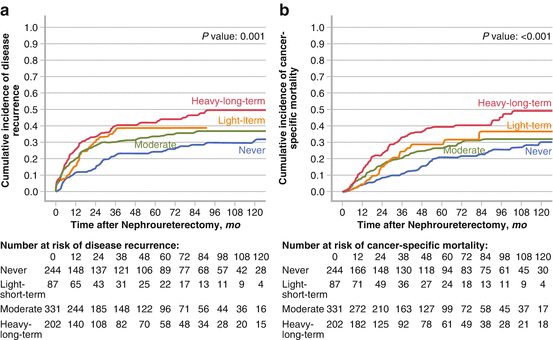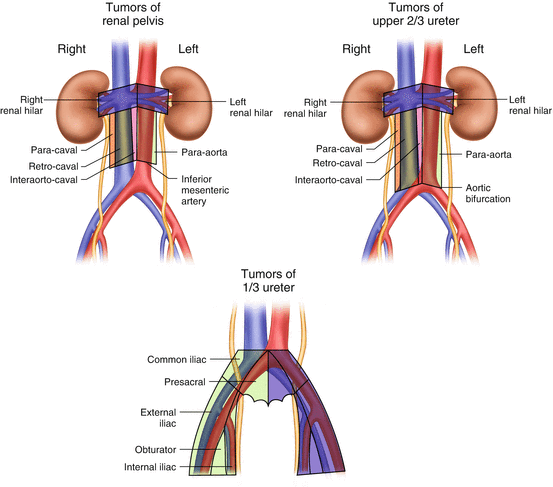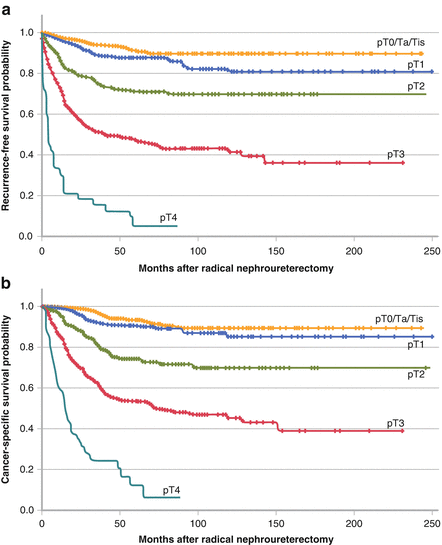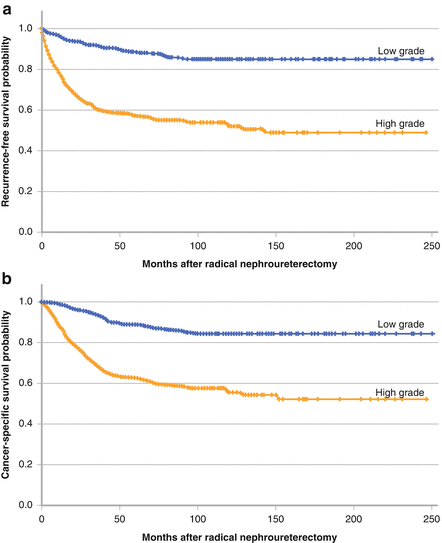Characteristics
Comment
References
Age
Advanced chronological age is an independent predictor of DR, CSM, and OM
Gender
No impact of gender on outcomes
[15]
Race
Afro-American race independent predictor of CSM
Comorbidities
− ECOG-PS ≥ 1 is an independent predictor of OM
− ASA score independent predictor of CSM
Obesity
Body mass index ≥ 30 is an independent predictor of DR, CSM, and OS
[2]
Smoking exposure
Smoking status and cumulative exposure associated with DR, CSM, and OM
Patient Age
Several population-based and multicenter studies have reported that advanced patient age is an independent predictor of cancer-specific mortality (CSM) after RNU [12–14]. The mean age at diagnosis is around 70 years old and thus significantly older than renal cell carcinoma. Changes in the biologic potential of the tumor, with UTUC being more aggressive in elderly patients, as well as to differences in care patterns (e.g., greater reluctance to perform radical surgery in these individuals) could be an explanation for this finding. Based on the evidence, age should not be an exclusion criterion for RNU as the complications of this procedure in the elderly are not excessive or much different from their young counterparts.
Patient Gender
Patient Race
The incidence of UTUC appears to be increasing in most racial groups, mostly because of earlier detection. While a multicenter study performed at academic centers did not show any difference between races [16], Afro-Americans have been shown to have worse outcomes compared with other racial groups [17]. As with many diseases, whether this is due to differences in biological processes or more likely due to differences in health attitudes and access to care remains to be evaluated.
Comorbidities ASA and ECOG
Eastern Cooperative Oncology Group performance status (ECOG-PS) has been shown to be independently associated with higher perioperative mortality and overall mortality (OM) after RNU, but not disease recurrence (DR) and CSM [18]. Conversely, the French collaborative group reported an association of ASA score with cancer-specific mortality after RNU [19]. In a recent study, addition of ECOG to a multivariable model including standard clinicopathological features was significantly associated with DR and CSM, while age lost its association [14]. Thus, these findings need further investigation and validation.
Obesity
The prognostic role of obesity has been demonstrated for several malignancies, such as renal cell and prostate cancer. A recent multi-institutional study examined the relationship between body mass index and oncologic outcomes in UTUC patients [2]. The authors reported that a body mass index ≥30 was associated with DR, CSM, and OM. Further studies need to investigate the biological rationale of such findings and whether this risk can be modified.
Smoking Status and Cumulative Exposure
Smoking exposure represents an established risk factor for the development of UC [20]. A recent multicenter study investigated the relationship between smoking exposure and prognosis of UTUC patients [21]. The authors showed that smoking status (current versus never) and cumulative exposure (heavy long-term smokers: >20 cigarettes per day and >20years) were associated with both DR and CSM (Fig. 4.1) [21]. Interestingly, smoking cessation of more than 10 years mitigated these detrimental effects [21]. The authors concluded that smoking cessation programs should be integral parts of the cancer care administrated to UTUC patients.


Fig. 4.1
Estimates of disease recurrence and cancer-specific mortality incidences according to the cumulative smoking intensity in 864 upper tract urothelial carcinoma patients treated with radical nephroureterectomy. Adapted from Michael Rink, Evanguelos Xylinas, Vitaly Margulis, Eugene K. Cha, Behfar Ehdaie, Jay D. Raman, et al. Impact of smoking on Oncologic Outcomes of Upper Tract Urothelial Carcinoma After Radical Nephroureterectomy. European Urology null 2012 null http://dx.doi.org/10.1016/j.eururo.2012.06.029
Disease-Related Factors (Table 4.2)
Table 4.2
Prognostic factors of upper tract urothelial carcinoma related to the disease
Characteristics | Comment | References |
|---|---|---|
Hydronephrosis | Presence of hydronephrosis is associated with higher stage, DR, and CSM | |
Symptoms | Systemic symptoms are associated with metastatic disease | |
Tumor location | The impact of tumor location on outcomes results in contradictory findings | |
Tumor multifocality | Presence of multifocal tumors is an independent predictor of CSM | |
Tumor size | Tumor size >3 cm is an independent predictor of DR and CSM | |
Previous/synchronous bladder cancer | Presence of a previous or synchronous bladder cancer is an independent predictor of IVR |
Hydronephrosis
Symptoms
The presence of systemic symptoms such as pain or weight loss has been associated with presence of higher-stage and higher-grade UTUC [26] and OM in patients treated with RNU for UTUC [27]. Further multi-institutional efforts are still needed to validate this predictor. With more advanced imaging studies, most of the patients with systemic symptoms will be likely identified as metastatic.
Tumor Location
The impact of tumor location (renal pelvicalyceal system compared with ureter) on the prognosis of patients with UTUC is controversial. Several single-institutional studies initially reported that ureteral location was associated with worse outcomes [28, 29]. A recent multi-institutional French study confirmed these findings [8]. On the contrary, several other population-based and multi-institutional studies found no association of tumor location with oncologic outcomes after RNU once adjusted for tumor stage [5, 30]. To conclude, the currently available retrospective studies do not permit a definitive conclusion regarding the impact of tumor location on UTUC prognosis. However, while there is a differential impact of tumor location on tumor stage, lymph node status and tumor stage are more powerful drivers of tumor biology and clinical behavior.
Tumor Multifocality
Multifocal tumors are defined as tumors with two or more distinct locations within the urinary tract. Tumor multifocality (occurring in at least 30 % of patients) in retrospective studies has been shown to be an independent predictor of CSM (Fig. 4.2) [8, 31]. Tumor presence in both the renal pelvicalyceal system and ureter is worse than either location with regard to cancer-specific outcomes [32]. Based on the current literature evidence, tumor multifocality should be routinely determined by clinicians with adequate sampling and reported by pathologists.


Fig. 4.2
Kaplan–Meier plots of progression-free and cancer-specific survival stratified according to tumor multifocality in 2,492 patients treated with radical nephroureterectomy for upper tract urothelial carcinoma. Adapted from Thomas F. Chromecki, Eugene K. Cha, Harun Fajkovic, Vitaly Margulis, Giacomo Novara, Douglas S. Scherr et al. The Impact of Tumor Multifocality on Outcomes in Patients Treated With Radical Nephroureterectomy. European Urology Volume 61, Issue 2 2012 245–253. http://dx.doi.org/10.1016/j.eururo.2011.09.017
Tumor Size
Tumor size is an established predictor of cancer-related outcomes in several malignancies. A cutoff of tumor diameter of 3 cm and 4 cm has been associated with occurrence of metastasis [33] and intravesical recurrence after RNU [34], respectively. Both these studies need validation in studies with larger cohorts. From clinical experience, Ta tumors can reach a large size and have a low risk of becoming invasive. Whether tumor size is an accurate predictor of biological behavior of an individual tumor remains to be determined.
Clinical Tumor Grade and Stage
Endoscopic evaluation (+/−biopsy) establishes the definitive diagnosis of UTUC and helps risk stratify patients towards conservative or radical management. Biopsy grade is accurate and can help predict pathologic findings [24]. Unlike lower tract UC, the clinical staging of UTUC is difficult because biopsies that include underlying muscle are generally not possible [35]. Imaging studies can help improve clinical staging based on the presence of hydronephrosis (see above) and invasion in soft tissue [36].
Surgery-Related Factors (Table 4.3)
Table 4.3
Prognostic factors of upper tract urothelial carcinoma related to the surgery
Characteristics | Comment | References |
|---|---|---|
Delay of treatment | A delay >3 months associated with higher stages in invasive UTUC | [40] |
Surgical approach | Outcomes between open and laparoscopic RNU are not different | |
Distal ureter management | − Lack of complete bladder cuff removal associated with DR and CSM − Endoscopic distal ureter management associated with IVR |
Delayed Surgery
In lower tract UC, a delay between diagnosis and radical cystectomy (≥3 months) is considered to have a negative impact on prognosis. In UTUC, a multi-institutional study investigated the prognostic impact of the time interval between diagnosis and RNU on oncologic outcomes [40]. The study showed that a longer interval (≥3 months) was also associated with advanced pathological stage, DR, and CSM in patients with invasive disease [40]. This data together with that from the lower tract indicated that once the tumor becomes invasive, which is difficult to assess clinically in UTUC, one should proceed to definite therapy in a time-sensitive fashion.
Surgical Approach
Open RNU (ONU) with excision of a bladder cuff is considered the gold standard treatment of invasive or high-risk noninvasive UTUC regardless of the location of the tumor in the urinary tract [1]. Laparoscopic RNU (LNU) has emerged as a minimally invasive alternative to ONU, with advantages in terms of lower blood loss, shorter length of hospital stay, and shorter convalescence [41, 42]. To date, only one prospective randomized trial showed no difference in terms of DR and CSM between LNU and ONU [43]. In non-organ-confined tumors LNU was inferior to ONU. This difference could be attributed to surgeon experience and other factors such as the differential use of lymph node dissection between the two groups. A population-based study (with a propensity score matched analysis) and a meta-analysis of retrospective studies confirmed the safety of LNU with regard to oncologic outcomes when compared to ONU [41, 42]. As long that one abides to the oncologic principles, there should be no difference between the different approaches.
Distal Ureter Management
Excision of the bladder cuff is mandatory for invasive or high-risk noninvasive UTUC [1]. Moreover the procedure must comply with oncological principles, which consist of preventing tumor seeding by avoiding entry into the urinary tract during tumor resection. Resection of the distal ureter and its orifice is performed because it is a part of the urinary tract with considerable risk of tumor recurrence. After removal of the proximal part, it is almost impossible to image or approach it by endoscopy during follow-up. Recent publications on survival after RNU have concluded that removal of the distal ureter (bladder cuff) improves prognosis after RNU [44]. Moreover, endoscopic distal ureter management has been associated with a higher risk of intravesical recurrence (Fig. 4.3) [9]. While there have been a variety of techniques described for the management of the bladder cuff, complete removal is what really matters. Techniques such as ureteral stripping lead to incomplete surgery and should be avoided [1].


Fig. 4.3
Intravesical recurrence-free survival in 2,681 patients who underwent radical nephroureterectomy for upper tract urothelial carcinoma according to the distal ureter management. Adapted from Evanguelos Xylinas, Michael Rink, Eugene K. Cha, Thomas Clozel, Richard K. Lee, Harun Fajkovic et al. Impact of distal ureter management on oncologic outcomes following radical nephroureterectomy for upper tract urothelial carcinoma. European Urology null 2012 null. http://dx.doi.org/10.1016/j.eururo.2012.04.052
Lymph Node Dissection
Lymph node dissection (LND) during RNU allows for optimal staging of the disease and may have a therapeutic role [45]. However, the anatomical sites of LND have not yet been clearly defined. Specific LND templates are likely to have a greater impact on patient survival than the number of lymph nodes removed (Fig. 4.4) [45, 46]. The cumulative data from the literature on this subject suggest that a LND should be performed during RNU or distal ureterectomy for invasive UTUC [1, 45]. The templates for LND need to be defined through large multicenter template studies. Similarly to lower tract UCB, a pathological nodal staging score has been proposed in order to predict the probability of a patient staged as pN0 to be truly node negative (Fig. 4.5) [47]. However, all data are retrospective; consequently, underreporting of the true rate of node-positive disease is likely.



Fig. 4.4
Role of lymphadenectomy in the management of urothelial carcinoma of the bladder and the upper urinary tract. Templates of lymph node dissection for upper tract urothelial carcinoma according to tumor location. Role of lymphadenectomy in the management of urothelial carcinoma of the bladder and the upper urinary tract. Adapted from Kondo T, Tanabe K. International Journal of Urology. Volume 19, Issue 8, pages 710–721, 19 APR 2012 DOI: 10.1111/j.1442-2042.2012.03009.x http://onlinelibrary.wiley.com/doi/10.1111/j.1442-2042.2012.03009.x/full#f2

Fig. 4.5
Pathological nodal staging score in 814 patients treated with radical nephroureterectomy for upper tract urothelial carcinoma. Adapted from Evanguelos Xylinas, Michael Rink, Vitaly Margulis, Talia Faison, Evi Comploj, Giacomo Novara, et al. Prediction of true nodal status in patients with pathological lymph node negative upper tract urothelial carcinoma at radical nephroureterectomy. The Journal of Urology Volume 189, Issue 2 2013 468–473. http://dx.doi.org/10.1016/j.juro.2012.09.036
Pathologic Factors (Table 4.4)
Table 4.4
Prognostic factors of upper tract urothelial carcinoma related to pathologic features
Characteristics | Comment | References |
|---|---|---|
Pathologic tumor stage | Advanced pT stage is an independent predictor of DR and CSM | |
Pathologic Tumor Grade | − Higher tumor grade is an independent predictor of DR and CSM. − Both the 1973 and the 2004 WHO classifications of tumor grade independently predict cancer control outcomes | |
Concomitant CIS | Concomitant CIS is associated with advanced tumor stage and grade and is an independent predictor of IVR, DR, and CSM | |
LVI | Presence of LVI associated with advanced tumor stage/grade, DR, and CSM, specifically in pN0 patients | |
Tumor architecture | Sessile tumor associated with DR and CSM | |
Tumor necrosis | Controversial impact on oncologic outcomes | |
LNI | Presence of LNI associated with DR and CSM |
Tumor Stage
Pathologic tumor stage represents the best-established predictor of survival in patients with UTUC and should always be considered in the preoperative and postoperative counseling of these patients, specifically in the determination of the intensity of postoperative surveillance and the decision-making regarding adjuvant therapies and trials (Fig. 4.6) [39, 48].


Fig. 4.6
Outcomes of radical nephroureterectomy: A series from the Upper Tract Urothelial Carcinoma Collaboration. Kaplan–Meier plots of progression-free and cancer-specific survival stratified according to tumor stage in 1,363 patients treated with radical nephroureterectomy for upper tract urothelial carcinoma. Outcomes of radical nephroureterectomy: a series from the Upper Tract Urothelial Carcinoma Collaboration. Adapted from Margulis V, Shariat SF, Matin SF, Kamat AM, Zigeuner R, Kikuchi E, et al. Cancer 2009. Volume 115, Issue 6, pages 1224–1233, 20 JAN 2009 DOI: 10.1002/cncr.24135. http://onlinelibrary.wiley.com/doi/10.1002/cncr.24135/full#fig2
Tumor Grade
Tumor grade represents another well-established predictor of cancer-related outcomes in patients with UTUC because it is strongly related to the single cell behavior and tumor stage (Fig. 4.7). Both the 1973 and the 2004 World Health Organization (WHO) classifications are predictive of outcomes [48, 49]. Tumor grade should always be taken into account in the preoperative and postoperative counseling of these patients. Specifically in the preoperative setting, tumor grade can help guide decision regarding RNU versus endoscopic management.


Fig. 4.7
Outcomes of radical nephroureterectomy: A series from the Upper Tract Urothelial Carcinoma Collaboration. Kaplan–Meier plots of progression-free and cancer-specific survival stratified according to tumor grade in 1,363 patients treated with radical nephroureterectomy for upper tract urothelial carcinoma. Outcomes of radical nephroureterectomy: a series from the Upper Tract Urothelial Carcinoma Collaboration. Adapted from Margulis V, Shariat SF, Matin SF, Kamat AM, Zigeuner R, Kikuchi E, et al. Cancer. 20009. Volume 115, Issue 6, pages 1224–1233, 20 JAN 2009 DOI: 10.1002/cncr.24135. http://onlinelibrary.wiley.com/doi/10.1002/cncr.24135/full#fig
Concomitant Carcinoma In Situ
Concomitant carcinoma in situ (CIS) of the upper urinary tract represents a rare entity that is considered to be associated with DR and CSM in patients with organ-confined disease [50]. Moreover, presence of concomitant CIS is associated with intravesical recurrence after RNU [51, 52]. Therefore, the presence of concomitant CIS should always be evaluated in patients with UTUC, because they may require more aggressive surveillance regimens and strategies utilizing topical therapies.
Lymph Node Invasion
The presence of lymph node invasion (LNI) is considered an important prognostic factor, indicating the metastatic spread of a tumor to its lymph nodes [45, 48]. In patients with LNI, lymph node density (≥30 %) may help risk stratify patients with regard to DR and CSM [53]. Extranodal extension appears to be a powerful predictor of clinical outcomes in patients with LNI [3, 53]. LNI is an important prognostic factor in patients with UTUC. Efforts are still needed to standardize the indications and LND templates.
Lymphovascular Invasion
In retrospective studies, lymphovascular invasion (LVI) is present in approximately 20 % of UTUC and it represents an independent predictor of DR and CSS specifically adding information in patients with lymph node negative UTUC [4, 54]. LVI status should be reported in the pathologic report of all UTUC specimens [4, 54]. Consensus regarding the pathologic definition of LVI needs to be reached.
Tumor Architecture
Several studies have investigated the prognostic impact of tumor architecture (sessile compared with papillary) on the survival of patients with UTUC. Three multi-institutional studies found that a sessile/infiltrative growth pattern was associated with features of aggressive disease, DR, and CSM [48, 55, 56]. These findings suggest that tumor architecture should always be mentioned during the endoscopic evaluation of UTUC, as well as in the gross description of the pathological reports.
Tumor Necrosis
Extensive tumor necrosis (defined as >10 % of the tumor area) is an independent predictor of oncologic outcomes in patients after RNU [57]. However, a recent multicenter international study failed to confirm these findings [58]. Thus, the prognostic role of tumor necrosis in UTUC patients needs further confirmation in larger well-designed multi-institutional studies. Whether it adds to other pathologic features thereby impacting clinical decision-making remains to be proven.
Positive Surgical Margins
The presence of positive surgical margins is reported in ≤8.5 % of RNU cases and strictly depends on the management of the bladder cuff. Presence of positive surgical margins has been associated with higher rates of DR and CSM [59]. One needs, however, to differentiate between ureteral positive margin and soft tissue positive margin. While both negatively impact outcomes of the patient, soft tissue positive margins lead to fast demise of the patient [59].
Histological Variants
In retrospective studies, almost 25 % of patients with UTUC treated with RNU harbor histological variants [60]. Variant histology was associated with features of aggressive disease [60], but not with oncologic outcomes when adjusted for the effects of standard clinicopathological features [60]. Moreover, variant histology does not seem to affect response to adjuvant systemic chemotherapy in patients treated with RNU [61]. Future studies may allow to differentiate between the different types of variant histology.
Molecular Markers (Table 4.5)
Table 4.5
Summary of the molecular markers in the upper tract urothelial carcinoma patients
Markers | Function | Method | Comment | References |
|---|---|---|---|---|
Tissue-based | ||||
P53 | Cell cycle regulation | Immunohistochemistry | Overexpression is associated with advanced T stage and higher tumor grade | [62] |
Ki-67 | Cell proliferation | Immunohistochemistry | Overexpression is associated with advanced T stage and higher tumor grade. It is an independent predictor of synchronous/metachronous bladder cancer | [63] |
EGFR | Cell proliferation and differentiation | Immunohistochemistry | Overexpression is associated with advanced disease and metaplastic differentiation | [64] |
HIF-1α | Angiogenesis | Immunohistochemistry | Overexpression is an independent marker of DR and OM.
Stay updated, free articles. Join our Telegram channel
Full access? Get Clinical Tree
 Get Clinical Tree app for offline access
Get Clinical Tree app for offline access

| |



